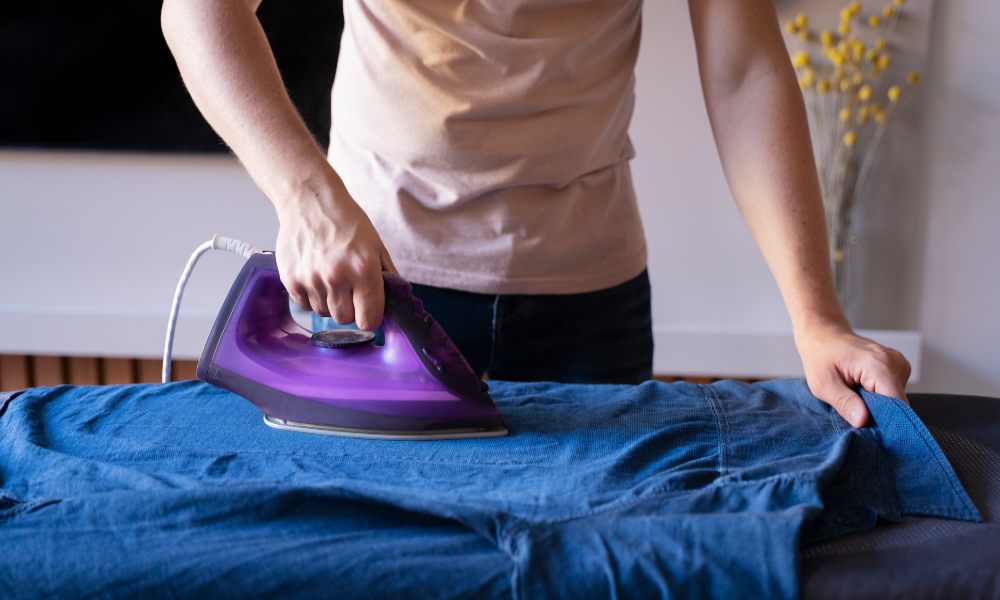Can you safely iron an iron-on patch onto polyester fabric? You can put an iron-on patch on polyester with the proper techniques and care without damaging the delicate synthetic fabric. In this article, we’ll explore how iron-on patches work and the best practices for applying them to heat-sensitive fabrics like polyester using a low-heat iron, pressing cloth, and performing in sections.
What Are Iron-On Patches?
Iron-on patches, embroidered patches, fabric patches, or custom patches are decorations that can be adhered to clothing and fabrics using heat from an iron. Common types of iron-on patches include:
- Embroidered patches made of thread in intricate designs
- Woven patches with an adhesive backing
- Dye sublimation patches printed on special transfer paper
- PVC patches made of vinyl
The primary benefit of iron-on patches is that they can be applied using just household materials – an iron and ironing board. No sewing skills, special equipment, or fabric glue is required. This makes iron-on patches a versatile decoration option to quickly customize denim jackets, t-shirts, hats, bags, and more.
Applying Iron-On Patches on Polyester Material.
Polyester fabric is artificial and produced from polymers that are derived from petroleum. It is known for durability, wrinkle resistance, and shape retention. However, polyester has a low tolerance for high heat. The fibers and fabric can become prone to scorching, melting, or warping when exposed to high temperatures from pressing with a hot iron.
Special care must be taken when using iron-on patches on polyester garments and accessories to avoid damage:
- Use a low heat setting on your iron, avoiding the high cotton and linen settings. Polyester melts between 250- 260°F, so the nylon/silk setting around 250°F or lower is best.
- Before using the iron, it’s recommended to place a parchment paper or pressing cloth over the patch. This will protect the patch and ensure that it is not damaged during the process. This helps diffuse the heat and prevent direct contact between the hot iron and polyester fabric.
- Iron the patch in 5-10 second bursts, lifting the iron and allowing the fabric to cool between presses. Keep the iron over one spot for a short time.
- Work on an ironing board and continually shift the garment or accessory as you press so no single area overheats — iron in small sections.
- For multiple patches, opt for a heat press instead of an iron. The even pressure ensures uniform heat distribution across all patches.
Alternatives to Ironing Patches on Polyester

If you are concerned about melting the synthetic polyester fabric, there are a couple of heat-free options for affixing iron on patches:
- Use fabric glue like Fabri-Tac to adhere to patches without direct heat on the material. Ensure the adhesive is suitable for the fabric and follow directions.
- Stitch the patches by hand or with a sewing machine around the edges. This avoids ironing while still securely attaching the patch.
Tips for Ironing Patches on Polyester
When ironing patches, follow these best practices:
- Use a temp setting like nylon/silk, never high-heat cotton/linen, which can scorch the polyester fabric
- Remember to cover each patch with a pressing cloth or parchment paper before ironing.
- Press in short 5-10 second bursts, allowing the fabric to cool between presses
- Keep the garment moving and iron in sections for even heating.
- Consider a heat press for multiple patches instead of an iron.
- Test an inconspicuous area first before ironing patches on polyester.
Key Takeaways
With the proper techniques, careful approach, and caution, it is possible to apply iron-on patches successfully onto polyester fabrics. The key is to use a low-heat iron, protect the fabric with an ironing cloth or paper, work in short presses, and distribute heat evenly to avoid scorching the synthetic material. With a gentle approach, iron-on patches provide a versatile way to customize tricky fabrics like polyester.
FAQs
What temperature should I use to iron patches on polyester?
Use the lowest temperature possible, around 250°F or lower. Avoid high heat settings, which can melt polyester. The nylon/silk setting is ideal.
Should I use steam when ironing patches on polyester?
Do not use steam, as it introduces excess moisture, which can damage the polyester fabric. Use a dry iron only.
What type of iron-on patches work best on polyester?
Patches made explicitly for synthetic fabrics will adhere better to polyester. Woven and embroidered patches work better than paper-backed patches.
How can I keep polyester from getting too hot when ironing on patches?
Use a pressing cloth to help disperse the heat. Work in 5-10 second increments, allowing the fabric to cool between presses fully. Keep the garment moving and shift to different areas.
Is it better to sew patches on polyester rather than iron them?
Sewing patches avoids direct heat risk to polyester. However, iron-on application is also safe with proper low heat and pressing cloth.
Concluding Question
Have you successfully applied iron-on patches to polyester or other synthetic fabrics? What tips and tricks have you learned? Share your experiences in the comments!
***
Main image: pexels.com




